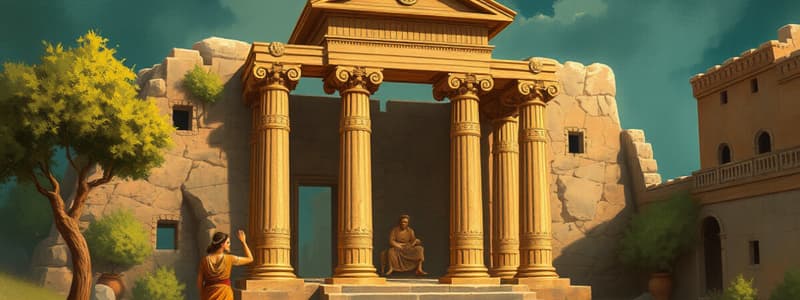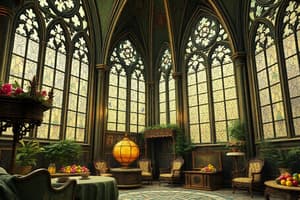Podcast
Questions and Answers
How does the Cista of Novios Plautios reflect Etruria's location?
How does the Cista of Novios Plautios reflect Etruria's location?
The Cista's material is extracted from the Etruscan countryside.
Which element of an Etruscan temple demonstrates Greek influence?
Which element of an Etruscan temple demonstrates Greek influence?
Columned porch
Etruscan tombs are known for their representations of
Etruscan tombs are known for their representations of
Leisure and festivities.
How is Married Couple Embracing typical of Etruscan figural art?
How is Married Couple Embracing typical of Etruscan figural art?
Apulu of Veii illustrates how Etruscans
Apulu of Veii illustrates how Etruscans
In what way does the portrait sculpture of Aulus Metellus illustrate the political context of the Republican period?
In what way does the portrait sculpture of Aulus Metellus illustrate the political context of the Republican period?
What distinguishes Roman portraiture during the Republican period from Greek Classical sculpture?
What distinguishes Roman portraiture during the Republican period from Greek Classical sculpture?
Why are the structure and function of the Pont du Gard described as 'marks of Roman civilization'?
Why are the structure and function of the Pont du Gard described as 'marks of Roman civilization'?
The plan of Roman urban temples reveals that they were built
The plan of Roman urban temples reveals that they were built
How does the Temple of Portunus illustrate Horace's claim that 'Captive Greece conquered her savage conquerors and brought the arts to rustic Latium'?
How does the Temple of Portunus illustrate Horace's claim that 'Captive Greece conquered her savage conquerors and brought the arts to rustic Latium'?
How does the Ara Pacis embody the political context of the Roman Early Imperial period?
How does the Ara Pacis embody the political context of the Roman Early Imperial period?
Roman villa plans typically include
Roman villa plans typically include
Roman imperial painters seemingly dissolve the walls they paint using
Roman imperial painters seemingly dissolve the walls they paint using
Most Roman cities were planned according to a grid model that had first developed in
Most Roman cities were planned according to a grid model that had first developed in
How does portraiture change in Early Roman imperial art?
How does portraiture change in Early Roman imperial art?
The Pantheon takes advantage of the Roman architectural developments of
The Pantheon takes advantage of the Roman architectural developments of
The Sarcophagus with Indian Triumph responds to what change in the Roman High Imperial cultural context?
The Sarcophagus with Indian Triumph responds to what change in the Roman High Imperial cultural context?
The Column of Trajan pictures the common Roman Imperial period theme of
The Column of Trajan pictures the common Roman Imperial period theme of
The Forum of Trajan exemplifies the Roman High Imperial use of architecture
The Forum of Trajan exemplifies the Roman High Imperial use of architecture
Commodus's portrait dressed as Hercules employs the typical Roman Imperial portraiture characteristic of
Commodus's portrait dressed as Hercules employs the typical Roman Imperial portraiture characteristic of
The Emperor Caracalla had himself depicted as a fierce ruler because the Late Imperial emperors
The Emperor Caracalla had himself depicted as a fierce ruler because the Late Imperial emperors
The Baths of Caracalla reflect the Late Imperial period persistence of Roman
The Baths of Caracalla reflect the Late Imperial period persistence of Roman
Tetrarchic portraiture corresponds to what historical event?
Tetrarchic portraiture corresponds to what historical event?
Tetrarchic portraiture is characterized by
Tetrarchic portraiture is characterized by
The relief sculptures on the Arch of Constantine demonstrate how the Late Imperial period appreciated art that
The relief sculptures on the Arch of Constantine demonstrate how the Late Imperial period appreciated art that
One way in which a Tuscan order column differs from one of the Doric order is that the
One way in which a Tuscan order column differs from one of the Doric order is that the
A groin vault is created by the intersection of two
A groin vault is created by the intersection of two
The purpose of a Roman triumphal arch is to
The purpose of a Roman triumphal arch is to
A barrel vault is a/an
A barrel vault is a/an
The Roman basilica is dedicated to
The Roman basilica is dedicated to
The exedrae at the Pantheon are located in the
The exedrae at the Pantheon are located in the
The coffers and oculus at the Pantheon are located in the
The coffers and oculus at the Pantheon are located in the
How does the portrait of Constantine illustrate continuity and change in Roman art during the Late Empire?
How does the portrait of Constantine illustrate continuity and change in Roman art during the Late Empire?
Flashcards are hidden until you start studying
Study Notes
Etruscan Art and Culture
- The Cista of Novios Plautios showcases local material, reflecting Etruria's geographic identity.
- Etruscan temples feature columned porches, revealing Greek architectural influence.
- Etruscan tombs depict themes of leisure and festivities, emphasizing their cultural values.
- The Married Couple Embracing exemplifies the lifelike intimacy characteristic of Etruscan figural art.
- Apulu of Veii demonstrates the integration of Greek deities into Etruscan religious beliefs.
Roman Portraiture and Political Context
- Aulus Metellus is a notable senator portrait, symbolizing the political hierarchy of the Republican period.
- Republican Roman portraiture contrasts with Greek Classical sculpture by emphasizing age and distinct individuality.
- The political context of the Ara Pacis manifests in its commemoration of imperial achievements during the Early Imperial period.
Roman Architecture
- The Pont du Gard aqueduct exemplifies Roman architectural innovation through its civic utility and the use of the arch.
- Urban temples in Rome were designed primarily for access to the interior cella, highlighting religious practices.
- The Temple of Portunus borrows features from Greek architecture, illustrating the cultural flow between Rome and Greece.
- Roman villa designs typically included cubiculae and tablinum, centered around a peristyle for spatial organization.
- The Pantheon is architecturally significant for its advancements in concrete and the use of a dome.
Changes in Roman Artistic Expression
- In Early Roman imperial art, portraiture combines idealization from Greek aesthetics with specific individual traits.
- The Column of Trajan reflects a recurring theme in Roman art: the celebration of imperial accomplishments.
- The Baths of Caracalla signify the continuation of large civic architectural projects during the Late Imperial period.
Late Imperial Roman Art
- Tetrarchic portraiture emerged in response to the empire’s administrative division, characterized by its geometric abstraction.
- The relief sculptures on the Arch of Constantine reveal a Late Imperial appreciation for both abstract and classical art forms.
- Commodus’s portrait as Hercules reflects a tendency toward idealized representations in Imperial portraiture, showcasing a Classical physique.
- The Emperor Caracalla’s fierce depiction underscores the rising threats the empire faced during the Late Imperial era.
Architectural Features
- The groin vault is formed by the intersection of two barrel vaults, enabling vast interior spaces.
- Roman triumphal arches serve to commemorate military victories, a key aspect of their civic architecture.
- A barrel vault is defined as a semicircular arch that extends into space, functioning as significant structural elements.
- The Roman basilica served important civic functions, acting as a site for various civic activities.
Pantheon Specifics
- Exedrae are situated in the walls of the Pantheon, contributing to the structure's interior design.
- The Pantheon's dome features coffers and an oculus, enhancing both its aesthetic appeal and structural integrity.
Studying That Suits You
Use AI to generate personalized quizzes and flashcards to suit your learning preferences.




